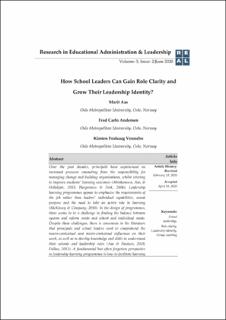| dc.contributor.author | Aas, Marit | |
| dc.contributor.author | Andersen, Fred Carlo | |
| dc.contributor.author | Vennebo, Kirsten Foshaug | |
| dc.date.accessioned | 2021-09-10T07:40:27Z | |
| dc.date.available | 2021-09-10T07:40:27Z | |
| dc.date.created | 2020-10-29T22:44:31Z | |
| dc.date.issued | 2020-10-02 | |
| dc.identifier.issn | 2564-7261 | |
| dc.identifier.uri | https://hdl.handle.net/11250/2775121 | |
| dc.description.abstract | Over the past decades, principals have experienced an increased pressure emanating from the responsibility for managing change and building organisations, whilst striving to improve students’ learning outcomes (Abrahamsen, Aas, & Hellekjær, 2015; Hargreaves & Fink, 2006). Leadership learning programmes appear to emphasise the requirements of the job rather than leaders’ individual capabilities, moral purpose and the need to take an active role in learning (McKinsey & Company, 2010). In the design of programmes, there seems to be a challenge in finding the balance between system and reform needs and school and individual needs. Despite these challenges, there is consensus in the literature that principals and school leaders need to comprehend the macro-contextual and micro-contextual influences on their work, as well as to develop knowledge and skills to understand their schools and leadership roles (Aas & Paulsen, 2019; Fullan, 2011). A fundamental but often forgotten perspective in leadership learning programmes is how to facilitate learning processes and help school leaders to gain role clarity and grow leadership identity. In this paper, we examine and discuss the way that newly appointed school leaders in Norway participating in a leadership learning programme can gain role clarity through investigation into role expectations and group coaching. We provide findings that shed light on aspects of how school leaders develop role clarity through taking an active role in learning within their workplaces and together with the school leaders participating in the leadership learning programme. | en_US |
| dc.language.iso | eng | en_US |
| dc.publisher | Turkish Educational Administration Research & Development Association | en_US |
| dc.relation.ispartofseries | Research in Educational Administration and Leadership;Volume: 5, Issue: 2/June 2020 | |
| dc.relation.uri | https://dergipark.org.tr/en/pub/real/issue/57078/804249 | |
| dc.rights | Navngivelse 4.0 Internasjonal | * |
| dc.rights.uri | http://creativecommons.org/licenses/by/4.0/deed.no | * |
| dc.subject | School leadership | en_US |
| dc.subject | Role clarity | en_US |
| dc.subject | Leadership identities | en_US |
| dc.subject | Group coaching | en_US |
| dc.title | How school leaders can gain role clarity and grow their leadership identity | en_US |
| dc.type | Peer reviewed | en_US |
| dc.type | Journal article | en_US |
| dc.description.version | publishedVersion | en_US |
| cristin.ispublished | true | |
| cristin.fulltext | original | |
| cristin.fulltext | original | |
| cristin.qualitycode | 1 | |
| dc.identifier.doi | https://doi.org/10.30828/real/2020.2.7 | |
| dc.identifier.cristin | 1843418 | |
| dc.source.journal | Research in Educational Administration and Leadership | en_US |
| dc.source.volume | 5 | en_US |
| dc.source.issue | 2 | en_US |
| dc.source.pagenumber | 518-551 | en_US |

